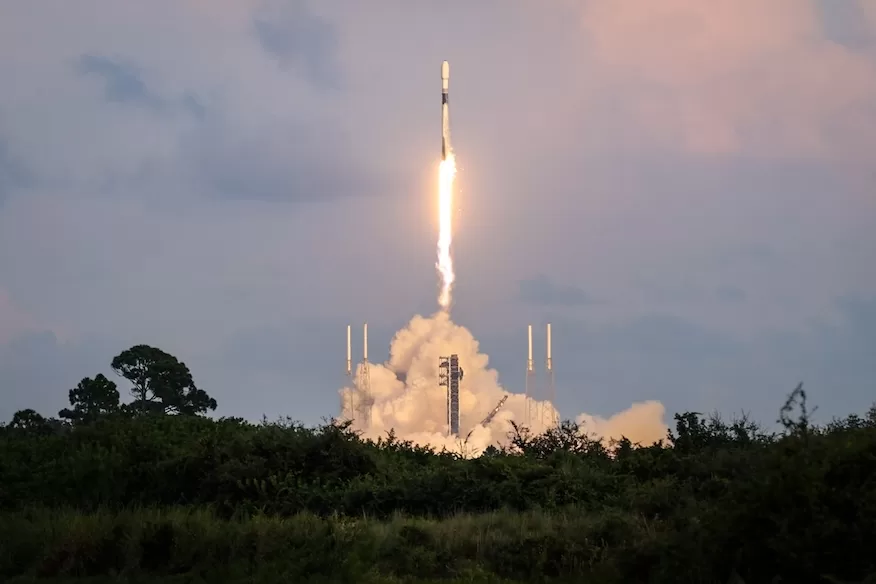A Falcon 9 rocket lifts off from Space Launch Complex 40 (SLC-40) at Cape Canaveral Space Force Station, carrying a pair of Galileo navigation satellites. Image: Adam Bernstein/Spaceflight Now
SpaceX launched two new Galileo navigation satellites for the European Union on September 17, 2024. The launch took place at 6:50 p.m. EDT from Cape Canaveral Space Force Station, marking another milestone in the ongoing collaboration between SpaceX and the European Union. The Falcon 9 rocket, powered by nine Merlin engines, lifted off from Space Launch Complex 40, carrying the pair of satellites into orbit for the Galileo satellite constellation.
The Galileo satellite system is crucial for the European Union’s navigation infrastructure, providing highly accurate positioning data to users worldwide. This launch was the second time Galileo satellites were launched from U.S. soil, with the previous mission, called L12, taking place in April 2024. The recent L13 mission is expected to enhance Galileo’s capability, further solidifying its position as the world’s most precise navigation system.
The launch, however, faced some uncertainty due to weather conditions. Leading up to the event, the 45th Weather Squadron had forecasted only a 40 percent chance of favorable conditions. Concerns were heightened by an area of low pressure off the southeast U.S. coastline, which brought clouds and the potential for thunderstorms to Florida. Despite this, SpaceX pushed forward with the mission, successfully launching the satellites as scheduled.
The Falcon 9 rocket’s first-stage booster, tail number B1067, made its 22nd flight. This particular booster has a remarkable history, having previously supported astronaut missions to the International Space Station (Crew-3 and Crew-4), as well as multiple cargo and Starlink satellite launches. After completing its latest mission, B1067 landed on the SpaceX droneship, ‘Just Read the Instructions,’ positioned in the Atlantic Ocean.
This successful booster landing was notable for several reasons. During the earlier Galileo L12 mission in April, SpaceX expended the Falcon 9 booster to provide additional performance to deliver the payload to orbit. This time, SpaceX was able to recover the booster by implementing design and operational changes, including mass reductions and trajectory adjustments. These modifications allowed for a safe recovery while still delivering the satellites to their intended orbit.
SpaceX acknowledged that the recovery of the booster was not guaranteed. The reentry trajectory subjected the booster to higher heating and dynamic pressure than most previous missions. Nonetheless, SpaceX viewed this as an opportunity to push the limits of its technology. The company emphasized that this landing attempt provided valuable data that would be used to further refine the design of future vehicles, making them more robust and reusable in challenging reentry conditions.
The Galileo satellites themselves are part of the Full Operational Capability (FOC) series, specifically designated FOC FM26 and FM32. These are the 31st and 32nd satellites launched for the Galileo constellation, which is managed by the European Union Agency for the Space Programme (EUSPA). The satellites, manufactured by Airbus, each weigh 2.3 tons and are expected to have a lifespan of 15 years. They were deployed into medium Earth orbit at an altitude of about 23,200 km (14,416 miles) above the Earth.
The Galileo system has been steadily growing in both size and capability. On September 5, 2024, EUSPA confirmed that the two L12 satellites, launched earlier this year, had completed their on-orbit commissioning and officially joined the constellation. This expansion makes Galileo the most accurate global navigation satellite system in the world, supporting over 4 billion users.
Rodrigo da Costa, Executive Director of EUSPA, highlighted the importance of this milestone. “These two new satellites strengthen Galileo’s position as the world’s most accurate positioning system. With the European Commission, EUSPA, and ESA collaborating closely, Galileo goes beyond just satellites; it stands as proof of our united dedication to innovation, security, and progress,” he said in a statement. Da Costa also noted that Galileo’s continued expansion creates new market opportunities for European businesses, small and medium-sized enterprises (SMEs), and entrepreneurs.
The Galileo constellation is a major player in the global navigation landscape, competing with systems like the U.S. GPS and Russia’s GLONASS. With each new satellite, Galileo enhances its global coverage, providing accurate and reliable positioning data to users across the world. This latest launch continues Europe’s efforts to maintain and expand its technological edge in the navigation space, ensuring that Galileo remains a key player in the industry for years to come.
As the European Commission, EUSPA, and SpaceX continue their collaboration, future launches are expected to further bolster the Galileo constellation. Each mission represents a step forward in Europe’s ability to provide cutting-edge navigation services to its citizens and the global community.
#SpaceXLaunch #GalileoSatellites #Falcon9 #EuropeanUnion #CapeCanaveral
